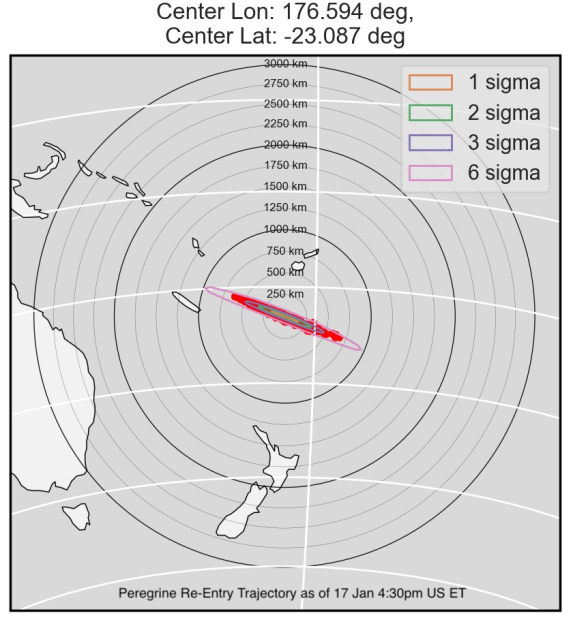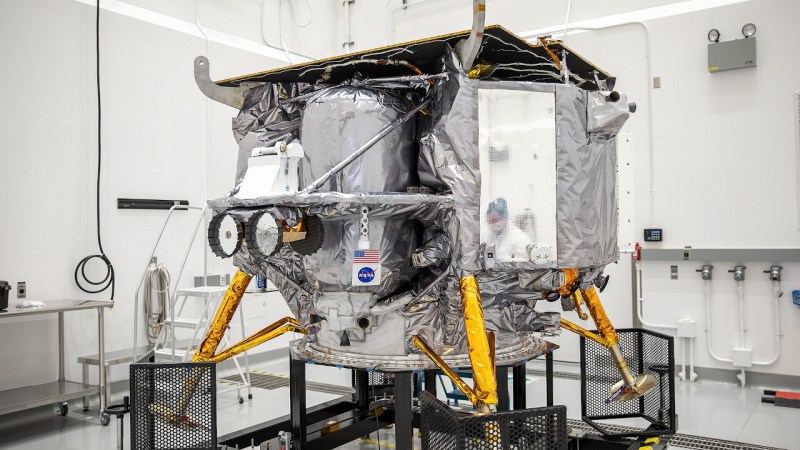Within a few hours of this post going live, Astrobotic’s Peregrine spacecraft is expected to burn up in the Earth’s atmosphere — a disappointing end to a mission that was supposed to put the first US lander on the Moon since the Apollo program ended in 1972.
In their twentieth mission update since Peregrine was carried into space on the inaugural flight of the United Launch Alliance Vulcan Centaur rocket, Astrobotic explains that the craft has been put on a trajectory designed to ensure it breaks up over a remote area of the South Pacific.

It was previously hoped the lander, which suffered a severe system malfunction just hours after liftoff, could have at least made a close pass of the Moon in lieu of touching down. But mission controllers felt the more responsible approach was to have Peregrine make a controlled re-entry while they still had the ability to maneuver it. The alternative, allowing the craft to remain in an uncontrolled orbit between the Earth and Moon, could potentially have caused problems for future Artemis missions.
Over the last ten days, ground controllers at Astrobotic have been working to piece together what happened to the doomed lander, while at the same time demonstrating a remarkable level of transparency by keeping the public informed along the way. It’s now believed that the stream of gas being expelled from a rupture in one of the craft’s propellant tanks was acting as a sort of impromptu thruster. This not only made the craft difficult to keep oriented, but also wasted the propellants that were necessary to perform a soft landing on the lunar surface.
Although the craft was eventually brought under control, the damage to the mission had already been done. While this obviously isn’t the ending that Astrobotic was hoping for, we have no doubt that the company collected valuable data during the craft’s flight through space, which took it approximately 390,000 kilometers (242,000 miles) from Earth.
As for us space nerds, we won’t have to wait long before another lunar lander makes its attempt. Japan’s Smart Lander for Investigating Moon (SLIM) should be touching down at around 10 AM Eastern on Friday (YouTube Live Stream), and the Nova-C lander from Intuitive Machines is scheduled to be launched aboard a Falcon 9 rocket sometime next month.















“we have no doubt that the company collected valuable data during the craft’s flight through space”
It’s not just the company. Powering up the payloads and letting them communicate is super-valuable too: they’ve now been verified to be able to operate in space for at least several days (which is probably long enough to verify stuff like radiation mitigation and thermal design and possibly telemetry/comms).
The science payloads definitely have flight spares, so it makes it extremely easy to apply for a next mission of opportunity when it comes along.
That doesn’t look too remote to me, it’s only 2200km from my place. Remote would be down near Pitcairn Island.
ONLY 2200 km!! … time to fabricate a protective double layer tinfoil hat.🤣🤣🤣
If I drove 2200km from here I’d still be within my home state. Hence the only.
Well they made it back to get to flush it down near the southern ocean gravity toilet hole.
Good that the road to the moon has less litter than it might have. More than LEO needs conservation from us explorers and exploiters. Eventually that will be the first interstate in space.
Yeah. About that. Have you seen the plans for where they plan to dump garbage from the Lunar Gateway Station? Hint: not to Earth, and not to the moon.
According to DSN (Deep Space Network) , Peregrine to Earth distans was dropping faster and faster to the range 30-something thousand km (much less than the geostationary orbit).
And after that distance started to increase. DSN (Canberra) lost(?) tracking at the distance about 58 thousand km.*
Conclusions:
– they missed the Earth (waaaay to far to de-orbit),
– they unintentionally used gravitational assist,
– Peregrine is out there… (out of control),
– …but nobody knows where,
– what came up, must go down – wait and see (…but be patient),
– we have +1 more “out of service” “scientific equipment” in the sky.*
Good job, Astrobotic. Keep the faith NASA.**
* I, as non-“A” form of “I” just can be wrong.
** “We do this not because it is easy
but because we thought it would be easy”
– end of sarcasm…
They can name the next lander Phoenix!
They should tell the team to design a probe to land on an asteroid, then at the last moment change it to ‘change of plans, it’s the moon now’
Seems that everybody CAN land on asteroids but not on the moon for some reason and perhaps by tricking them we can get things rolling :)